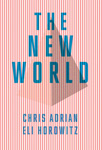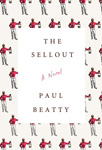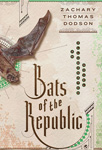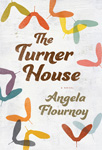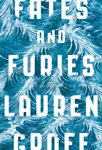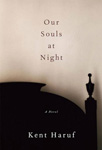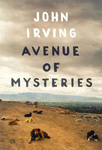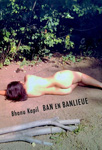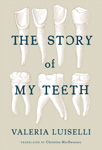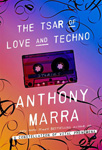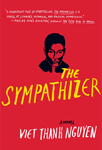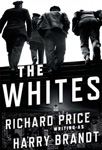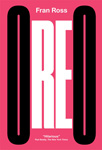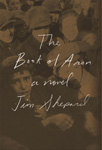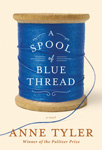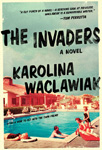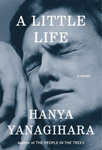by Chris Adrian and Eli Horowitz
Buy it at Powell’s »Choire Sicha: Hanya Yanagihara’s second novel, A Little Life, was the book that squatted atop the happiness of 2015 like a dodgy childhood memory. There was Bennett reading it in the Pines, all wild-haired and suspicious. There it was, actually being thrown across the room by Sara in New Harbor. How is it? you would ask; “I don’t know!” everyone would yell back, swamped by its methodical onslaught.
To begin to read A Little Life means that soon you will ask again why we read at all.
If you haven’t read it, and I can’t actually recommend that you do, A Little Life is the story of Jude, an ornately and extensively abused boy who becomes a shell of a man and also somehow a vicious Manhattan litigator. Jude also, unlike so many of our real vicious litigators, finally learns to love, for just a little while.
Throughout the year, critics wrestled with the idea that this monstrous story of slowly unfolding degradations might all just be allegory. “A world so unrealized it almost seems allegorical,” wrote Carol Anshaw in the New York Times Book Review, in a claim variously embraced and rebutted in other reviews. It “often feels more allegorical and archetypal than actual,” said Full Stop; it merely “uses the middle-class trappings of naturalistic fiction,” wrote Jon Michaud, oddly, in the New Yorker.
If not allegory, then it must be some manipulative literary pachinko machine: “More a concept than a character” is how Christian Lorentzen described Jude in the LRB, and “an adult player in a melodramatic lifestyle novel.” And: “Her novel is little more than a machine designed to produce negative emotions for the reader to wallow in,” wrote Daniel Mendelsohn in the New York Review of Books.
At the same time, Vogue called Yanagihara’s first novel “a dark allegory of Western hubris”; Mendelsohn described it as “a rather heavy-handed parable of colonial exploitation.” That first book is about a physician who goes to study a people in Micronesia and also rapes some children. One novel about child rape may be regarded as an accident. Two, though, begins to look like… what! Fecklessness? Callousness? Preoccupation?
To be fair, though, A Little Life only depicts about as much rape as any given HBO Sunday.
Anyway, each struggler in this way seized on the book’s own timelessness (a perpetual 2007, to Lorentzen’s ear) and its wonderful accurateness yet placelessness of New York, all the restaurants indicated but not named, the specific and dreamy vagueness that almost followed some unasserted rules. One character wins what is clearly a Golden Globe and then an Academy Award, both of which go unnamed. Something about reading A Little Life each night while in New York is like opening a door to another New York, identical but younger and hotter and maybe better, really, since everyone makes great piles of money and no one ever makes you go to therapy when you are discovered in your nightly cutting rituals.
While it—intentionally, I think—reads about as true as a fat folder of McMartin preschool trial evidence, and even as the word AIDS appears exactly once (and that particular illness is attributed to a character in an “off-off-Broadway production of La Traviata set in nineteen-eighties Fire Island”), A Little Life is not an allegory. An allegory would have a pointed point. Our allegory would reveal itself, at least on one page, as a coded discussion of a thing that is obvious. An allegory would not have Jude realizing something great and obvious and terrible: “Not having sex: it was one of the best things about being an adult.” The only point here is… love is fleeting? Don’t waste your life berating yourself? You don’t know what you’ve got ’til it’s gone? What is the point of this world!
Maybe it’s that suffering is not worthwhile? But if that’s the case, then just you put that book down right now honey! Go walk a lonely dog.
No one ever figured this book out, and isn’t that actually amazing?
Chris Adrian’s maddening 2006 novel The Children’s Hospital was long too, only about a hundred pages shy of A Little Life. I never did figure out what it was about—it was literally, or allegorically, about angels preserving a hospital for children at the end of the world. It sprawled and repeated and maddened. It suffered, I thought, from rulelessness.
In genre fiction, we talk far too much about “world-building.” But all worlds have rules, they have physics. There can be no world even communicated without some laws. To create Burroughsian chaos is almost always ultimately unsuccessful.
Adrian’s collaboration with Eli Horowitz, The New World, also spends much time in hospitals and it also suffers initially from this willful rulelessness. It opens cold on a woman mourning her husband, and her husband’s journey into a corporate contracted afterlife. There he must learn what is real in his unreal. There’s a bit of scrabbling to keep up for us; it is abbreviated and unforthcoming.
But the book gathers steam as you follow these two in their own worlds, and then, we begin to backtrack to their lives. Quite unexpectedly, the book blossoms into the most wonderful and devastating portrait of a marriage. Some of the sharpest and most exciting writing about family and loss that I’ve ever seen can be found in the back third of this book. It begins cool.
“Well, of course Jim’s thinking about a baby now,” her mother had told her, when Jane had gone up to Northampton alone to fetch the cat back, after a two-week trip to Puerto Rico to celebrate Jim getting off anticoagulants. “It’s like he’s finally all better. And he nearly died, didn’t he? Never mind that it was nearly two years ago to you and me. To him, it was probably yesterday. A little fender bender or ten pages of Camus was always enough to make your father come at me like a Mormon. Just give him some time. He’ll settle down. And he can’t be a surgeon anymore. He’s just looking for something to do with his life, isn’t he?”
“But did you want one?”
“One what, dear?”
Jane rolled her eyes. “A little Mormon.”
“Well, no,” her mother said, looking searchingly into her tea. “Not at first. And that’s all right, you know. It’s just two entirely different states of existence, the before and the after of it. Neither can understand the other, but one is also not inferior to the other.”
“I have no idea what you’re saying,” Jane told her. “But you know what I would never tell my child? I didn’t want to have a baby.”
“Jane,” her mother said. “You’re not a teenager. If you want me to help you in your discernment, you have to let me be honest with you.”
“But I don’t want your help,” Jane said. “I don’t even want to talk about this anymore. I just came here to get my cat!”
“Of course,” her mother said. “When have you ever needed anybody’s help?”
There’s flavors of all kinds of great things just in here, stretching that sick 100-meter-dash from Salinger to Highsmith, a chill that soon enough impeccably recedes as the emotions heat. It’s a short book. I wanted more, and it ends prematurely. This story, withheld, at last unfurls like some glorious banner which then collapses too soon to the dusty floor.
I felt cheated by it in an entirely opposite way from how I felt cheated by A Little Life, with its own decisions about withholding, the strange and obviously intentionally unsettling worldbuilding, and the book’s own great long unfurling of oppressive bloodletting and psychic trauma. And then also its strange choices in what to summarize, what to show and what to reveal. Why are we seeing this moment? Why are we not seeing this other? Why are some exchanges glossed by, and others, mundane, given full focus? At least the paragraphs are usually great, even when the sentences aren’t quite.
So let this be one more last laugh of that shitty old year 2015. Seems cruel that the book with the better writing should lose to the book that just has more writing. But there’s one crucial thing A Little Life has, and that is its sick and impeccably consistent and insistent bad touch. It’s a fever that never ends up breaking, a gross cut that never heals up. This nasty talent is what got all these hordes of people to read it, and isn’t that the greatest power of all? She got you people good. That’s a form of artistry as sophisticated and mysterious as actual witchcraft. I personally think it’s probably better that you don’t read A Little Life. But then when have any of us been able to stop people from hurting themselves?
None of the reviews that I’ve seen reveal the source of the title of the book. It sounds sweet, doesn’t it? In case you breezed past it, “a little life” is what young Jude’s father figure and pimp tells Jude to show with the customers during all the raping.
Match Commentary
By Kevin Guilfoile & John Warner
Kevin: There are so many things “wrong” with A Little Life that you and I could fill the multiple-decade span of its narrative just by enumerating them. Yanagihara writes (and writes well) in a realist voice, but there is nothing remotely realistic about the world she creates. Women are non-existent (there are a few wives/girlfriends lurking in the background, mostly to remind us which characters are the straight ones). As Choire (he’s been writing for TMN as long as I have, so I’ll pass on calling him “Judge Sicha”) says, there is no accounting for how Jude could suffer from the kind of physical and mental anguish he does and survive into his thirties, much less become one of the most successful litigators in New York. It is, in a way, a novel about male friendship, but I don’t recognize friendship as practiced by any these characters, whose lack of ambivalence is arresting. The amount of unconditional love on display here could be poured hot over pancakes.
John: Nummers.
Kevin: In fact, I don’t recognize the interior lives of these characters at all. Willem is, by all accounts, a committed heterosexual, but his love (or maybe pity?) for Jude is so intense that he develops an insatiable, obsessive physical desire for him. Although sex with other men doesn’t interest him, Willem’s love for Jude is so expansive it must include sex, which transforms Jude into a genderless object of his love/lust. Willem doesn’t seem to identify internally as queer in any way, but neither does he see anything incongruous about his relationship with Jude, which, for several hundred pages, is the primary business of this novel.
Reading A Little Life can be like staring at one of those cartoons in Highlights magazine where you’re supposed to pick out all the incongruities, like a bird with a bowler hat or a wagon with boots instead of wheels. This entire novel is a wagon with boots instead of wheels. Yanagihara’s tone suggests she wants you to invest deeply in the existence of this universe, but the characters that inhabit it make sense only as metaphor. That tension hits you with the force of a wave and it can be frustrating if you resist it, but kind of irresistible if you’re willing to be swept along by it. Across 700 pages, I did a lot of both.
John: It’s as though the events of A Little Life happen inside a kind of snow globe version of New York City. (It’s possible I lifted that comparison from a review I’ve read, but if so, I can’t find it, even after some extensive googling.) There are many recognizable things, but the characters are contained in a world that seems sealed against an external reality.
At times, many times, I found the novel ridiculous. I would groan and roll my eyes at some violation of the laws of verisimilitude (or even internal consistency, as you point out with Willem’s sexuality), but then it would manage to suck me back down into its world.
As the kids would say, this novel has no fucks to give over “reality,” or verisimilitude, and it therefore becomes its own thing.
Kevin: I think Choire gets to the heart of A Little Life’s appeal: It is compelling to read (in spite of everything I just said), hard to figure out (because of everything I just said), and it makes you experience something profound as you are reading it. That something is itself hard to describe except as a particularly acute form of empathy—those same kids would call it “feels”. (I know “empathy” is considered a dirty word in some political circles, so if you are a Trump or Cruz supporter or enjoy reading Scalia dissents with a brandy by the fire, this is probably not the book for you.) Yanagihara piles the woe on Jude to such a degree that as the pages turn your interior bullhorn is constantly screaming stop! But she never does. She never lets up, even when it’s obvious that she should, long past the point when this novel has scrubbed away any traces of realism or mercy.
Jude is a foie gras duck none of us can save.
Yanagihara has written a book about the limits of human suffering by packing the misery so far past the breaking point that we start to feel pain ourselves. I can’t think of a reading experience that is simultaneously so irresistible and unpleasant.
To roughly echo what Choire said: Do I recommend this book? Wholeheartedly. Do I recommend you read it? No.
But only because I love you so much.
John: It’s interesting that “love” is the subject for The New World as well, and in many ways, as Judge Sicha shows, it’s a far more illuminating exploration of the emotion than what we encounter in A Little Life. It’s a sneaky little novel that manages to deliver a significant emotional blow by the end, but it’s a single blow, a crystallizing moment.
In contrast, A Little Life is like getting worked over by George Foreman in his prime.
Past the halfway point of the opening round and one favorite (Fates and Furies) is down, but A Little Life survives. Tomorrow we have a young hotshot, Anthony Marra, up against an old(er) master, Jim Shepard, as The Tsar of Love and Techno meets The Book of Aron.

The official 2016 Tournament of Books T-Shirt by book designer Janet Hansen. Order yours!


